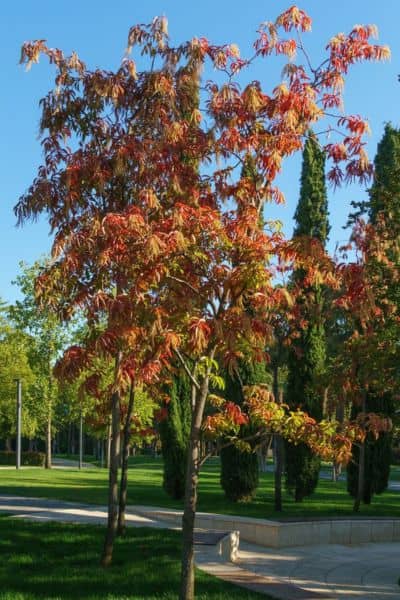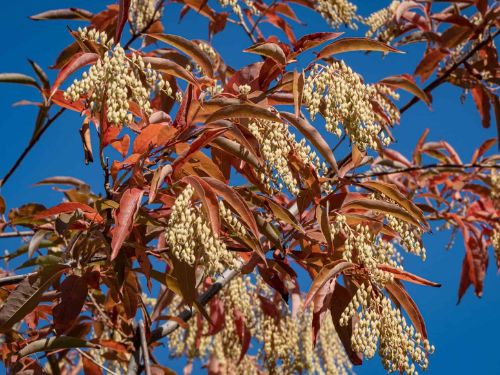The Sourwood tree, Oxydendrum arboreum, is native to the southeastern United States, thriving in the acidic soils of the Appalachian region. It can be found in various habitats, from dry, rocky slopes to moist lowlands. Whether used as a focal point, a wildlife attractor, or a source of distinctive honey, the Sourwood tree will captivate and enhance any outdoor space it inhabits.

Preferred Growing Conditions
While these trees are relatively low-maintenance, providing them with the right conditions ensures optimal growth and health. Here are some tips for caring for Sourwood:
- Soil Requirements: Sourwoods flourish in well-draining, acidic soils, typically with a pH range between 4.5 and 5.5, making them suitable for regions where other plants might struggle. Amending the soil with organic matter can promote a healthy root system.
- Watering: While Sourwood trees are somewhat drought-tolerant, regular watering is essential, especially during dry spells. Adequate moisture promotes healthy growth and helps the tree withstand environmental stress.
- Sunlight: While it can tolerate some shade, optimal growth occurs in full sun, contributing to its popularity in landscaping designs.
- Pruning: Pruning is best done in late winter or early spring. Although it is often minimal, removing dead or damaged branches shapes the tree to maintain its desired form.
- Mulching: Applying a layer of mulch around the base of the tree is beneficial and mimics the natural environment of the Sourwood.
- Pest and Disease Management: Sourwood trees are generally resistant to pests and diseases. However, monitoring for common issues such as scale insects or fungal infections is recommended, and appropriate measures should be taken if necessary.
Size, Shape, and Growth Rate
Sourwood trees reach an average height of 25 to 30 feet, although some specimens may grow taller under optimal conditions. The tree typically forms a pyramidal or oval shape with a straight trunk that branches out elegantly. The growth rate of Sourwood is considered moderate, making it an excellent choice for those seeking a tree that matures within a reasonable timeframe without becoming overly large.
Leaves and Flowers
One of the most distinctive features of the Sourwood tree is its foliage. The leaves are simple, alternate, and oblong, measuring 5 to 8 inches long. They are dark green during the growing season and transform into vibrant shades of red, orange, and purple in the fall. The autumnal display of Sourwood leaves is particularly striking, making it a sought-after choice for those who appreciate the beauty of fall foliage.
The Sourwood tree is renowned for its showy and delicate flowers, which appear mid-summer. The flowers are arranged in panicles, showcasing small, urn-shaped blossoms with a creamy white color. What makes these flowers exceptional is their abundance and their cascading effect, giving the tree a graceful and charming appearance during the blooming season. The nectar produced by Sourwood flowers is a valuable resource for bees, making it a pollinator-friendly addition to any garden.

Sourwood Nectar
One of the most notable characteristics is the production of sour-tasting nectar, hence the common name “Sourwood.” The nectar adds an interesting culinary aspect, and in certain regions, it has been used to make a distinct type of honey with a tangy flavor profile. This honey, sought after for its unique taste, has contributed to the economic value of Sourwood trees in certain areas.
Uses in Gardening and Landscaping
Sourwood trees have earned a special place in gardening and landscaping due to their aesthetic appeal, adaptability, and versatility. Gardeners often choose Sourwood for its stunning fall foliage. Its leaves turn various shades of red, orange, and purple, creating a breathtaking display in the autumn landscape. The picturesque appearance of Sourwood makes it a focal point in gardens, parks, or along driveways. Its ability to thrive in acidic soils makes it a resilient choice for various environments.
The nectar-rich flowers of Sourwood also attract pollinators, especially bees, making it a valuable tree for supporting local ecosystems. The tree’s ability to attract wildlife adds an ecological dimension to its role in landscaping. Sourwood trees contribute to local honey production in regions where they are prevalent. Sourwood honey is highly prized for its unique flavor.
